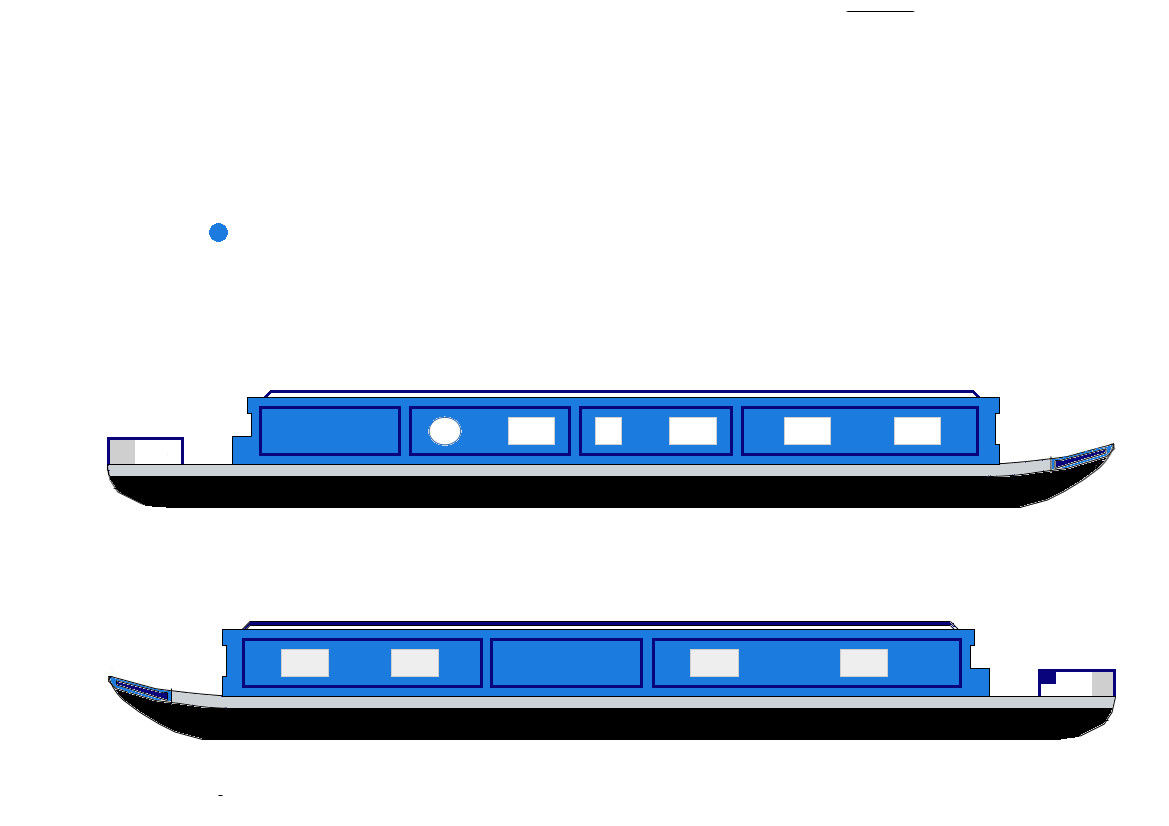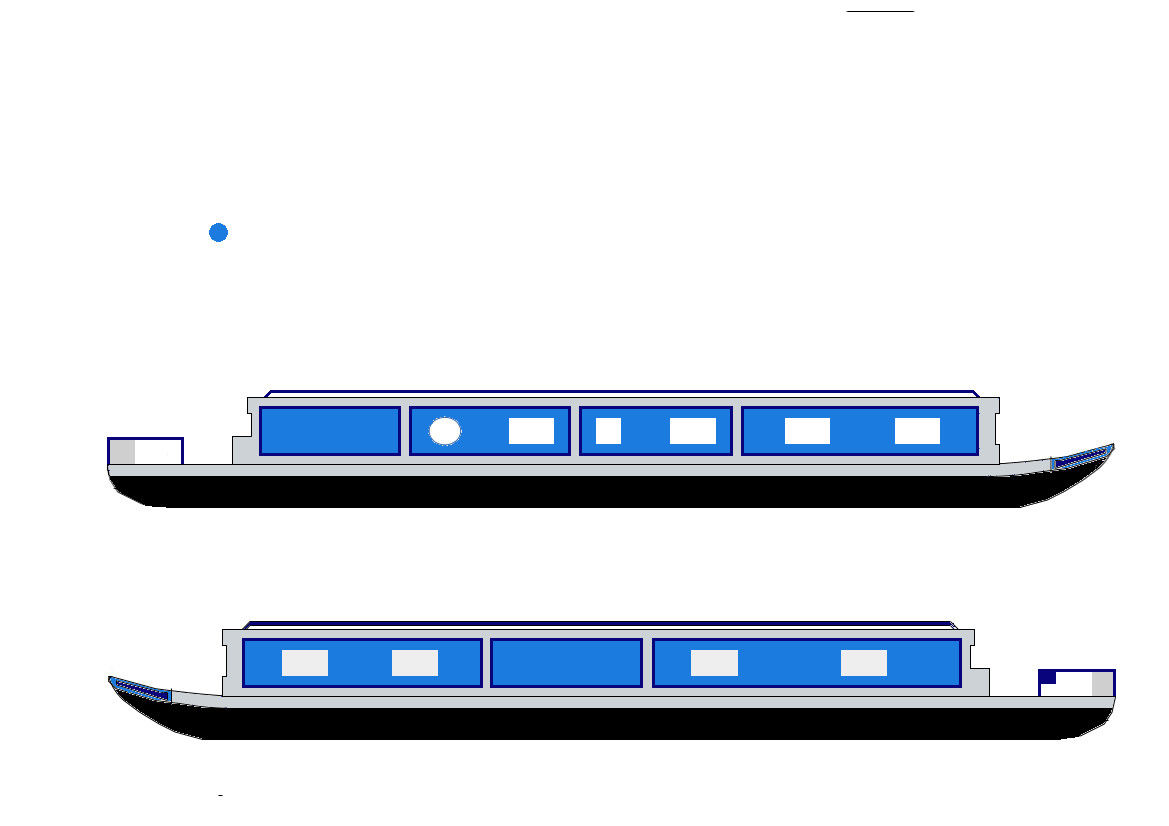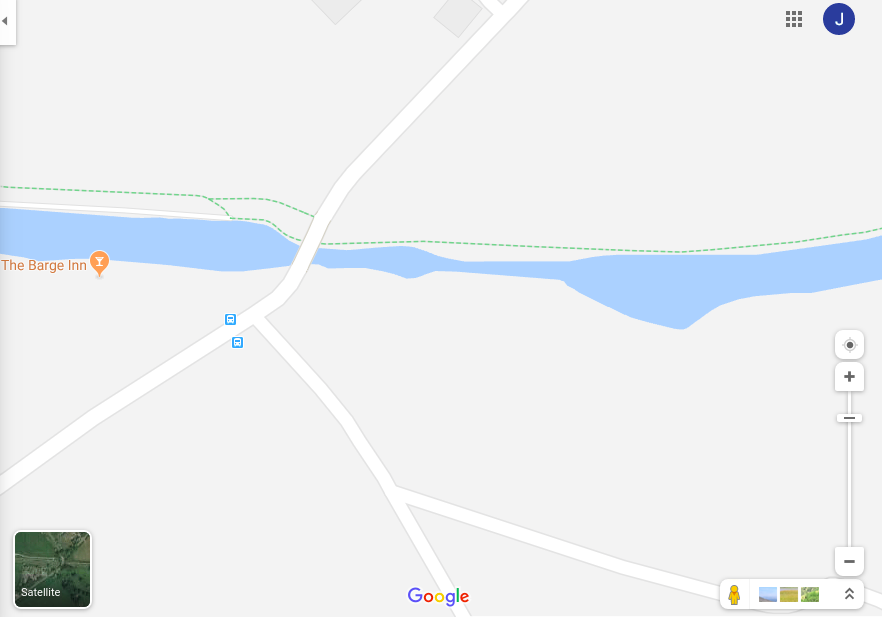

Johny London
Patron-
Posts
1,079 -
Joined
-
Last visited
Content Type
Profiles
Forums
Events
Gallery
Blogs
Store
Everything posted by Johny London
-

Narrowboat line drawing/side plan view
Johny London replied to Johny London's topic in Boat Equipment
Thanks all - I wanted to take pictures of each side then colour in, but I can't get the perspective where I am now. I've been on it all day - GIMP id not the most user friendly program to use. I've got light blue sides and light grey gunnels already so just want to add some panelling and lines to finish. Where do you get lining tape, can it come in whatever colour you want? How much is it and what's a good one!? I've done all combinations of scheme that take into account what I already have (tin of dark blue on standby) thinking like this... or -
I'm trying to make a line drawing of my narrowboat so I can experiment with different colour schemes on the 'puter - 2 hours in and I'm nowhere. Has anyone got a fairly generic image I can use? I need to be able to infill different colours and add windows, coach lines etc. At this rate it's gonna be quicker just to get the paint out
-
Thanks for all the great thoughts - I think something odd is going on, I'm going to think on it for a day or two while I finish painting in the engine bay - after all if it is loosing 5a then it's been going on for ages. BTW I don't spend my money on weed - and little on booze these days. And have a plethora of tools including plumbing etc.
-
Things are changing slowly, because the people who have money in oil also have a lot of influence. Not till they have a way of getting their money out of oil will we truly move forward - it's happening though - notice petrol stations rebadged as "energy" now? At least moving the generation to centralised places (power stations) it's easier to quantify and control the pollution and I think a more efficient approach anyway. One step closer.
-
Been doing that all afternoon - as in limited movement and vision - the engine bay painting is most tedious.
-
Yeh I know, cos I've also got one of those 240v ac meters About 1859w.
-
Good idea taking off the positives one by one - as they are quite a lot easier to get to than the negatives! I'll do that. I did think I'd "effectively" done that already with switching things off, but evidently not! I'm loath to by another meter, but if I can't get anywhere with the above method, at least it is an option. Yeh, I need to get that terminal thing changed asap, that's for sure. Hey the ammeter said -175a when the dishwasher was mid cycle! Cool.
-
I cant do that last thing without getting right in there again. It's quite agonising. In the meantime, I discovered that the mystery switch simply turns off the feed from the alternator! Why would I want to do that? I didn't think there was anything unusual about just daisy chaining the batteries (though appreciate it is not the theoretical ideal). Different take off terminals for convenience of fittings really. I've got a feeling it'll turn out to be something stupid like one of the batteries extra knackered (but that would still show current being drawn in not out?) or something similar. I did find a cracked battery terminal thing...
-

Kennet & Avon - Devizes - Bath - Devizes in 4 days ?
Johny London replied to jradley's topic in Holidays Afloat
The Barge food is pretty good, as is the Mill, the George ok and the one at Seminton ok-ish. Bt the one at Semington had excellent cider - something pig. -
Just did the shunt test suggested above - the ammeter does still read zero when the shunt connections are joined together (as well as o/c). To answer Alan - no the batteries are conventionally wired, as in the starter is on its own, the other four paralleled. What might look confusing is that the dc supply comes off one +ve terminal, (fourth leisure battery) and the supply to the inverter comes off two other ones (first and third leisure batteries) and mystery switch off the second, but they are all linked. I can't remember what or why the mystery switch is as it is, but it was like that from new - then again I've always had battery problems which we all put down to my own stupidity! If it did turn out that there really was a 5a drain I would feel rather vindicated - and possibly have been rather too hard on lead acid technology! I think a clamp meter would be very useful - annoyingly, I actually have one but it doesn't do DC current. Anything else I could be missing?
-
I got my ammeter hooked up finally (another thread on that). The problem is that it is showing -5a when everything is switched off. I'm trying to ascertain if it's a miss calibrated meter or if I am actually loosing current to somewhere (would certainly explain my battery woes over the years!). I can't easily remove the grounds one at a time (dreadful access to batteries) so I have worked the other way, methodically trying to eliminate things from +ve supplies. 1. Switched off 12v circuit breakers one at a time, then the master switch within the unit (it's a consumer unit style one). 2. I disconnected the inverter (on it's +ve supply, it was already switched off anyway). It always does a big spark so I know it uses something even when off). 3. Disconnected Webasto at its multi pin plugs. 4. Switched off an isolator switch in the engine bay (NOT the starter battery one, but one that is fed from the domestic bank and appears to go to the engine with a loom of wires - I can't remember what this is for, see pic below). That accounts for all the equivalent negative wires that are connected to the leisure bank. So, I am at a loss as what to work next - everything is off, yet the ammeter is -5a (obviously I disconnected the solar too). When the solar is on, it might show say 5 or 6 amps going into the batteries (on the mppt display) but there will still be a deficit on the ammeter (ie -3 or -4a). When the fridge cycles on, and there is good solar, I get what I'd expect, minus that extra 5 amps, so it seems to be ever present as far as I can deduce (obviously when the system is all on, it's dynamic and hard to be exact as things change from moment to moment). As far as the mis calibrated meter idea goes, disconnecting the sense wires but leaving the unit powered causes it to read zero. The meter does read +ve when the panels are doing ok, but I'd say still by less the 5 amps. Am I wasting my time, just a faulty meter? Or are there things I haven't considered yet? Felt sure that a logical process of disconnecting would yield results but not so far. I know someone will say the only way is to take off the negative leads one at a time but I think I achieved the same thing with the positives of the relevant circuits? I can't get in there easily - let alone with my dvm in ammeter mode, for example. I'm beginning to lean towards a duff meter, even as I fiddled, the soc has gone up by 2% despite the ammeter reading in the -ve Here's a picture of the isolator switch in the engine bay.
-

Kennet & Avon - Devizes - Bath - Devizes in 4 days ?
Johny London replied to jradley's topic in Holidays Afloat
Yes but he was talking about going up to the Barge was he not? -

Kennet & Avon - Devizes - Bath - Devizes in 4 days ?
Johny London replied to jradley's topic in Holidays Afloat
There is what looked like a winding hole after the lock east of the Barge, I don't know if it's an official one though. Funny enough I was with a boat looking to wind (which they did further up just west of swing bridge 150). You can see it on google though the map shows it more clearly than the photos. Might or might not be deep enough. -
No - I haven't missed a bit - if you read back through the post, I was trying to source a short cable and couldn't get one anywhere! I think like this, perhaps it's not aesthetically pleasing, but electrically speaking it's even better, as Wotever points out. I also took the opportunity to wedge the battery temperature sensor in between a couple of the batteries, so that is up and running now. And I moved the Webasto wire too Just need to find out where a stray 5amps is going!
-
As it was so difficult trying to source what I wanted, I did indeed have a harder try at making things fit as is. Managed to get the shunt to sit properly on the battery terminal itself, there was only one way it would go as its lug ends are very large - it's pointing away from where the cables go so a bit counter intuitive but there was enough play in the cables to do this and it is done up properly nice and tight. Again though - what an absolute bitch of a job trying to do anything on those batteries - access is a joke. A ten minute job ended up taking an hour and a half, plus a few bumps and scratches. Will be interesting to see what the current shows at various times. Just rea;ised I forgot to move the Webastos ground!
-
Just wiped it all down - dried off no problem, looking good and didn't rust again!
-
Just wondering whether I should clean off the fertan first (with either water or meths?) or just paint over. I think it says you can paint over. Not sure what I did in the past but this is such a large area can't afford to mess up! Edit to add: Directions for Use 1) Remove loose rust and grease as described above. 2) Dampen the metal surface. (don’t do this if just ‘dotting’ stonechips on car bodywork). 3) If applying by brush or sponge pour sufficient Fertan® into a suitable clean container. 4) Apply liberally by brush or sponge or airless spray. All rusted areas will turn black over the next 1 - 24 hours (moisture & temp dependent). 5) In dry conditions the surface should be dampened with a light water mist after two hours to facilitate the reaction and maximise effectiveness 6) If any rust has not converted apply more Fertan® at any time. The reaction can continue for up 48 hours. This provides the maximum performance. 7) At the end of this time wipe down or wash surface with low pressure water (ie not pressure wash) to remove the loose black dust that will be present (rust too loose to bond). This will also rinse off any unused (brown) Fertan lying on the metal. On large exterior structures rain will do this. ? When the surface is dry paint/coat as normal. 9) Brushes, sponges and spray equipment should be cleaned with water, preferably within a few hours.
-

Kennet & Avon - Devizes - Bath - Devizes in 4 days ?
Johny London replied to jradley's topic in Holidays Afloat
Having just recently done this stretch, I'd say a stop at BoA (just west of the lock there's plenty of vm's handy for the town) and if you get the chance a stop near Dundas aqueduct (easy mooring at or just west of). Also - The Bathampton Mill does great food (esp on Sunday) if you have time. It's a beautiful stretch, you need longer. -
That's a really neat idea! I'll have a look at it all again when I tog up to paint in the engine bay.
-

Separate mini inverter for oven ignition and fan
Johny London replied to Poppin's topic in Boat Equipment
Oh - just spotted this - I was reading the instructions from Shoreline today and they say about not connecting anything else to the fridge supply, because it will cause a voltage drop that can cause the fridge to cut out. -
I got some Isopon zinc primer - it says can be diluted with cellulose so should be good - will try it out anyway.
-

Charging batteries by generator and generator recommendations
Johny London replied to B2019's topic in New to Boating?
If the o/p can stretch to it - could be worth investing in a built in diesel genny such as s Fischer Panda - they come up very frequently on ebay 1-2k, and some come with all the bits and pieces you need, pipes etc. More initial outlay and hassle, but ultimately very convenient. -
Yes that's right - I have decided to go with the popular opinion and wire everything after the shunt. And my inverter charger has 90mm2 cable (think the cable to the dc stuff is like 50mm2 or something) so definitely want st least a 90mm2 link to the shunt. However, trying to get hold of one is proving very difficult. I've tried two boat yards, a metal place (welding) and two car places. No one carries the cable, or can put one together (I have some suitable lugs already, or (in the case of one place) can be bothered. No joy online either - Midland have the cable alone at £23 a meter! Was hoping to pay not more than that for the whole thing made up (only need 300mm or less). At this rate I might have another look to see if I can somehow get the shunt straight onto a battery terminal - I couldn't last time but now I know how difficult the link cable is I might try a bit harder.
-

Consultation on exhaust emissions on inland waterways
Johny London replied to GUMPY's topic in General Boating
I'm perfectly serious, as you well know Mike. A large solar array for charging the propulsion batteries will mean there's always enough power to keep the domestic bank happy when you are not moving - as per Peterboats 3.7kw - I reckon he'll get enough even in the winter. Boating has never been cheap - I calculated sometime ago that it costs me £14 per kw/h, using the engine as a genny, so solar and lithiums soon earn back their cost. Nothing to to do with scruffy boats either, mine's not exactly a palace. I DO use a webasto for water heating of course, but would be happy to look at other solutions. -
Turning off the fridge overnite - when I've had to do this, I usually run the engine first thing, so the extra consumption for an hour or two as the fridge works to get back down to temp is covered by the engine - that or the solar which kicks in after being "off" over nite. So, it does make some sense - even though not ideal and I try to live properly and keep the fridge on - a bastion of civilisation. Actually, whenever I wake in the night, the fridge is normally running so I don't think it somehow doesn't use much over nite!






